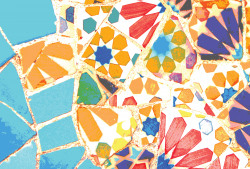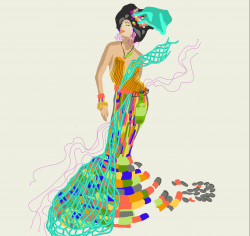When Lisa Birnbach’s The Official Preppy Handbook came out in 1980, its prime audience was the yuppies who had just graduated from college and were about to be riding high through the Reagan administration—namely, our parents. But while TOPH parodied the lives of preppy college and boarding school students, Birnbach’s True Prep is geared towards those who’ve grown up, weathered a divorce or two, and still wear their collars high. Anyone who has a summer home will agree that there are some pretty accurate and funny caricatures in here. Unfortunately, this book could easily be abused as a guide to fitting in with Lacoste crocodile wranglers. The dust jacket reads “HUMOR” over the barcode, but the text endears the preppy lifestyle more than lampoons it.
From its extensive and visually offensive graphic art (blue and yellow stripes assault the eyes and cocker spaniels abound) to its tag line “It’s a whole new old world,” True Prep has the aesthetic and verbiage down pat. My favorite graphic was the Kennedy half dollar sporting a popped collar and Wayfarers.
The book covers every conceivable aspect of the preppy lifestyle, mostly through lists of what you should be doing (sailing), lists of where you should do it (the Hamptons); and even lists of what to eat while you’re there (Triscuits). It even contains a preppy cookbook. “The True Prep Master Reading List” and “The Preppy Mix Tape” are well-selected but predictable, including tracks by the B-52s, Talking Heads, and Vampire Weekend, along with “all of [F. Scott Fitzgerald’s] work.” Are you a baby boomer divorcee trying to plan a tasteful second wedding? Advice lies within!
In 1980, the preppy aesthetic was only identified with WASPs, but in True Prep, Birnbach declares that preppiness is open to everyone. There are sections on black preppies, gay preppies, and Muslim preppies.
One thing remains the same though: preppies love stuff. See “Shopping as Recreation.” You want to dress like the people in this book? It tells you exactly what to buy. Its wardrobe section doesn’t merely exhaust the subject of style, it includes credits in the back listing every item pictured in the book. It’s basically a glorified shopping list. All the usual suspects are here including odes to the Bean Boot and Brooks Brothers, along with a page on “Logology” describing the nuanced differences in size and history between the Lacoste croc, the Polo pony, and the Brooks Brothers fleece logos.
Birnbach also plugs brands that weren’t around the first time around in 1980. The book offers company bios of Vineyard Vines, needlepoint belt maker Tucker Blair, and Thom Browne (whose work does not seem nearly conservative enough to be considered preppy, despite his collaboration with Brooks Brothers). There’s even a blurb on Ralph Lauren, who was considered “too new” in 1980 to be included in TOPH. The biggest change between 1980 and today? Patagonia.
The meticulousness of this book is impressive, but it’s unnecessarily lengthy. From 20 pages on the most successful preppies, “The New Pantheon,” (The Obamas and Fantastic Mr. Fox make the cut) to three pages on loafers, True Prep is more anthropological than tongue-in-cheek, something I feel like taking notes in rather than chuckling at. This ends up being its biggest weakness. After all, the term “prep” originated as a pejorative term.
We at Georgetown are no strangers to preppies. Not so long ago, we had a croquet club. In the end, this book will only be most helpful to those trying to get off their country club’s waiting list. True Prep gives detailed and accurate snapshot of the prep-set in 2010. Some of the clothes have changed, but they’re still filthy rich, selfish, and oblivious. So if you really want to fit in with the pastel posse, heed every word of True Prep, but don’t blame us for calling you a tool.




